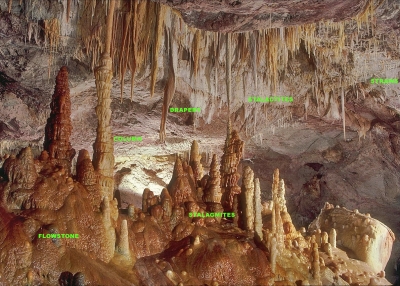
Stalactites hanging from the ceilings of caverns commonly exhibit a central tube or the trace of a former tube whose diameter is that of a drop of water hanging by surface tension. A drop on the tip of a growing stalactite leaves a deposit only around its rim. Downward growth of the rim makes the tube. The simplest stalactite form, therefore, is a thin-walled stone straw, and these fragile forms may reach lengths of 0.5 m (20 inches) or more where air currents have not seriously disturbed the growth. The more common form is a downward-tapering cone and is simply a thickening of the straw type by mineral deposition from a film of water descending the exterior of the pendant.
There are many other types of mineral formations found in caves. Some deposits are named based on their appearances, such as a showerhead, which is a hollow cone-shaped formation, or a conulite, which is a “splash cup” that forms when water dripping rapidly through the cave ceiling flings aside loose particles on the cave floor. And the list goes on.
Some caves are fully submerged, underwater. Studying underwater caves, such as those in Bermuda, can give us clues about how climate and sea level have changed over time. This knowledge can, in turn, help us better understand and respond to current climate and sea level fluctuations.
Credit : Britannica
Picture Credit : Google




